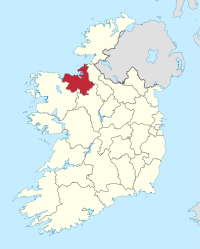County Sligo
| map | |
|---|---|
| Basic data | |
| Country: | Ireland |
| Administrative headquarters: | Sligo |
| Province: | Connacht |
| Irish name: | Sligeach |
| Surface: | 1837 km² |
| Residents: | 65,357 (2016) |
| License Plate: | SO |
Sligo ( Irish : Sligeach , after its eponymous capital today = the shell-rich area / river) is a county ( county ) in the province of Connacht in the northwest of the Republic of Ireland .
geography
Sligo is one of the most sparsely populated counties in Ireland. To the east are the Ox Mountains . The south is dominated by agriculture .
The city of Sligo is surrounded by three bays on the sea side and is guarded by mountains on the land side - the Knocknarea , on which, according to legend, the tomb of Queen Maeve is located, and the table mountain Ben Bulben , at whose feet William Butler Yeats , a famous one, is buried was an Irish poet (Sligo is therefore also called Yeats County ). The natural charm of the landscapes lies in the forests, lakes, steep mountains and the coast with its sandy beaches.
Sligo is more characterized by its regional culture, as it is expressed in the works of local musicians, poets and painters.
history
4000 years BC BC people cultivated the region and also survived thanks to the gathering of mussels, oysters and other mollusks and shellfish ( Culleenamore Middens ). A causewayed camp has been excavated at Magheraboy and an inland promontory fort ( Knoxspark ) has been excavated as evidence of the first peasant settlers. About three miles south of the regional airport, one of the largest accumulations of megalithic remains in Europe has been found. Carrowmore is an archaeologist's paradise. Interested visitors have the opportunity to discover an environment of prehistoric man. There are 132 verifiable megalithic sites in County Sligo .
The city of Sligo was founded in the time of the Vikings ; the abbey and castle were built in the 13th century, like many others (e.g. Ballymote) in the county at that time.
Due to the fact that Sligo is in a strategic location (on the road leading to the north), the county has often been the victim of attacks by clan chiefs as well as the English. In 1588, ships of the Spanish Armada were destroyed by a storm on the wide beach of Streedagh. Some Spaniards who were found by residents managed to escape the English and return to Spain. In 1570 today's county was founded. She also played a role in the war of rebellion in 1798; the Franco-Irish army succeeded in driving back the English. At Carricknagat a statue was erected in memory of Bartholemew Teeling for his role in this battle. In the mid-19th century, many people had to emigrate from the county during a particularly severe famine . The population fell from 181,000 (1841) to 57,000 (1956).
politics
The distribution of seats in the county council after the local elections on May 23, 2014:
| Political party | Seats |
|---|---|
| Fianna Fáil | 8th |
| Fine Gael | 3 |
| Sinn Féin | 2 |
| Non-party, small groups | 3 |
economy
Agriculture consists of sheep and cattle breeding. The wind farm operator Airtricity has several wind turbines for electricity generation in operation; otherwise there is little industry. In many places peat is still extracted today . Tourism is an important source of income.
Cities
Sligo is the county's capital. Other larger towns and villages are Inishcrone / Enniscrone, Tubbercurry , Ballymote , Carrickbanagher , Dromore West .
Attractions
- Ben Bulben Table Mountain
- Boyle Abbey
- Cabragh , Wedge Tomb
- Carrickglass , (or the Labby Rock) Portal Tomb
- Church Island in Lough Gill
- Creevykeel , Court Tomb
- Carrowkeel , Passage Tombs
- Carrowmore , megalithic structures including Listoghil
- Carrownamaddoo 2 , Passage Tomb
- Causewayed enclosure of Magheraboy , fencing
- Cloonameehan Monastery , founded by the Dominicans in 1488
- Cloverhill , Passage Tomb
- Coolbeg , Wedge Tomb
- Heapstown , Cairn
- Innishmurray Island Monastery with Beehive-huts (private crossings)
- Kesh Corran Cairn
- Keshcorran Caves caves
- Knocklane Promontory Fort
- Knocknarea mountain with cairn of Queen Maeve
- Knocknashee Hillfort
- Knoxspark , Promontory Fort
- Magheraghanrush Court Tomb
- Rathcroghan
- Sligo Abbey
- Tawnatruffaun , Portal Tomb
- "Yeats County" at Ben Bulben with the poet's grave, the remains of the round tower and the Celtic cross ; in and around Drumcliff
Personalities
The Dublin-born poet and Nobel Prize winner William Butler Yeats was very inspired by the region of Co. Sligo; this is how the word Yeats County came about.
Francis Taaffe and Brother Walfrid were from Ballymote, Sligo .
Sligo is home to three Westlife members: Kian Egan , Shane Filan and Mark Feehily .
Leo Milligan (father of Spike Milligan ) was a native of Sligonian; on June 26, 2005, a plaque was unveiled in his honor.
Elizabeth Rosanna Gilbert, known as Lola Montez (born February 17, 1821 in Grange, United Kingdom of Great Britain and Ireland, † January 17, 1861 in New York) was an Irish dancer and a lover of King Ludwig of Bavaria.
Individual evidence
- ↑ Survey of the Megalithic Tombs of Ireland: Vol. V, County Sligo by Seán Ó Nualláin
Web links
- Official site of the county government
- Sligo Airport
- Sligo newspaper
- Travel in Western Ireland
- A tour of Sligo
Coordinates: 54 ° 10 ′ N , 8 ° 36 ′ W


